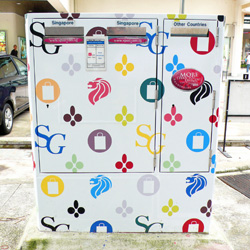Aesthetic Grounds: May 2007 Archives
At this moment, my wife and I are attempting to guess that if the Turkish military invades northern Iraq, then will our long planned and long desired trip to Istanbul be ruined. Today the Turkish prime minister signaled that he would support an attack against the Kurdish rebels after the suicide bomb in central Ankara. Our plane leaves in 36 hours. In any case, Turkey, Germany or Florida, I am taking a vacation for two weeks from the Blog.
Here are a few sites of civicly coordinated volunteer artworks. Please send me more sites.
Electrical Distribution Boxes in Brisbane, Australia
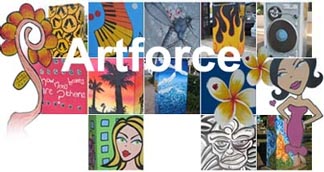
Electrical Distribution Boxes in Gilhorn, Germany
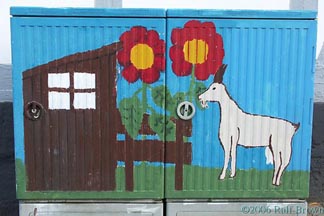
Painted Bus Shelters in Seattle Area, USA
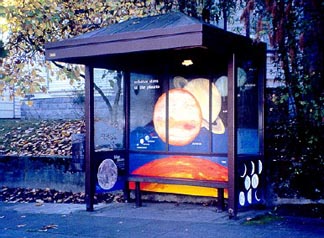
Video on Santa Cruz, California Boxes
The cows, the horses, the flamingos, the gators, the swans and now - the Globes - well Cool Globes. ( Great marketing pun. ) Home of the first American fiberglass on parade, Chicago puts the first "content" on the fun vaudeville displays. Called Vaudeville since the works are full of mild humor, bad puns, mediocre get-ups, gaudy colors, shiny things and a lot of noise. The events are the only American visual art displays that include artists of all ilk - museum, gallery, crafts, amateur, children and untrained celebrities. We all claim to be democratic so it's good to have an artworld version.
The best fiberglass on parade was the 2003 swans of Lakeland, Florida. The quiet placement in the green around the downtown lakes seemed unforced. The very pretty works made a pleasant stroll in the mild winter.
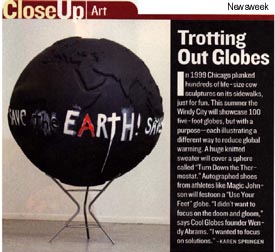
Cool Globes in Newsweek
Chicago's content -Global Warming Solutions - is a new twist. Both for the content at all and for the utilization of an idea, not a bovine, etc, to symbolize the city. Mayor Richard Daley has moved diligently and quickly to match Seattle's Mayor Greg Nickels and others in civic bending toward the reduction of green house gas emissions. The project has already generate the media attention that pleases Daley with previews in Newsweek. The exhibition on the Chicago waterfront runs from June 1 to September.
Exhibitions - private, public and illegal - in which artists respond to social or political issues has been around most of the 20th century with much more frequency after the Vietnam War. After many anti-war and feminist exhibitions, some art groups such as "Group Material" in the 1980s made an art of asking artists to make art. I personally come from this generation artist "askers" with exhibitions about homelessness, eviction, public art and US-Soviet Relations.
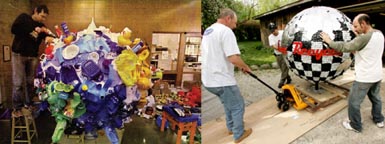
Artists Yair Engel and Mitch Levin in the Local Suburban Papers
I have no idea about the quality of the works in Chicago, but I am amazed that an exhibition of political commentary and propaganda by artists is completely acceptable. More than acceptable - sponsored by a major basically middle of the road American city. Did Greenpeace or Act-up think they would make political statement part of mainstream art? Did HBO - with Angels in America or The Wire - know that the USA would become more comfortable with social criticism in art?
Yes it is still safe with a theme like Global Warming where only far-off big corporations are sort-of to blame for their ignorance. No direct personal attacks and "solutions" are stressed rather than criticism. But if Chicago can celebrate visual art with a direct communication and narrative purpose, why was the 2006 Art Basel empty of content? Why is every architecture award given to the latest use of new technology? Why does any content in permanent public art need to be explained? Don't we have a public language regarding society that can place readable stories in the corners and skies of our cities? The time has come to stop fretting about a return to 1980's post-modern narrative and just start speaking in our visual language.
As far as I know, the first repeating object public art event in Chicago was Full Circle by Suzanne Lacey in 1993. 100 boulders were dropped in the night on Chicago sidewalks with plaques about important women in the history of Chicago. At the time in the city, no monuments or artworks were dedicated to any women. The rocks stayed on the streets for four months (typical fiberglass of parade timeframe) without a permit or civic blessing. The project was provocative in execution - illegally using the public space - and conceptual in visual language. To the critical thinker, the discovery of random boulders - the stuff of Chicago buildings and monuments - lead to all kinds of wandering thoughts. But now the audience for artistic expression has expanded and the visual language more consistent. A new Lacy would speak differently today. I await her appearance.
One Note:
Mayor Daley is apparently changing one of the basic rules of public art program administration. Last Friday, Daley and City Council eliminated the professional and citizen selection panel process. In its place, the City has instituted a program of at least two community meetings (with community identified by the local alderman) to select the art. The Chicago papers think this will send the selection process into the smoke-free back rooms of the politically connected.
Two Information Requests
1. What monuments or artworks to women have been installed since 1993?
2. How does this new Daley selection process work?
Some information here. Paul Klein's Art Letter Blog provides an assessment and a link to the actual modified Chicago ordinance.
Globe Maker Binns and Painting Warehouse in Spring (photo Bouzide)
First Net Image: Globe by Paul Bouzide and Catherine Schwalbe-Bouzide Photo by Bill Friedman.
Since the second "Cows on Parade" opened in Chicago in 1999 with 300 fiberglass bovines, 39 cities have re-inacted the event worldwide. This year includes Milan, Copenhagen and Istanbul.
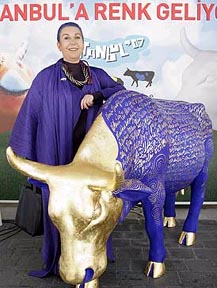
Unidentified person in photo from Turkish Daily News
Istanbul Cows on Parade opens on August 1, 2007.
Buckingham Guard and Gormley Casting (Photo by Edz, Flickr)
In London, Antony Gormley spreads cast-iron multiples of his own nude body across the skyline near the Hayward Gallery. (At Art Basel Miami last December, I noticed that all the naked people in the artworks were male.) The sculpture is a factual, asexual self-representation without any spirit or energy. It just is.
He uses a pose that mimics the comfortable "attention" posture of the Buckingham Palace guard - a real person playing the role of an interchangeable, repeating generic statue. Both guard and Gormley portrait fail to respond to external stimulation. Human interaction is photographic (take my picture with....) and imaginary like a child imagining a conversation with the doll.
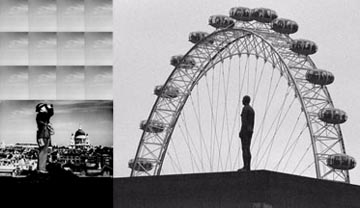
WWII Spotter ----and----- "Event Horizon" (photo by Doctor Boogie, Flickr)
With Gormley, the pictures taken are silhouettes of loneliness in the city with the suggestion of suicide. Although most people have no experience seeing people at the edge of roofs, we have a filmic memory of the suicide waiting to jump. (The BBC TV news story suggests suicide and one flickr photographer transforms it into denial "Art attempts to jump") As the Flickr photos shows, people capture this lonely moment against the sky with ease.
Gormley might be an expert at creating works that generate an "artistic" photograph among the general public. The vast majority of carefully framed photographs of the stoic figures at both "Another Place" and "Event Horizon" look pretty good. Just line-up the lonely silhouettes against the gray waves or gray skies with a bit of beach or city. No one can take a bad picture of the Angel of the North.
Gormley's work reveals that contemporary monument is the millions of photographs, not the work itself. To succeed, the work must link psychologically to the generic photographic and filmic memory. Here the actual space plays a role. When in the city plaza surrounded by rooftop figures or on the beach with a 100 figures staring out to sea, our mind sees filmic images of mindless zombies or of cultural hopelessness. Each person shoots with an instinctive camera knowledge that moves back and forth from the pan of mass desperation and to the close-up of individual paralysis.
I guess fortunately the British citizen has the capacity to say "its just art". But this is denial of a psychological acceptance of depression, loneliness and suicide. In other cultures (and other films) these figures would be in the tomb or standing at the end of the territory to warn or to frighten the outsider. Here the figures surround the Londoner reminding each person of the emptiness of the 21st century life -lonely and with only death as the highest aspiration.
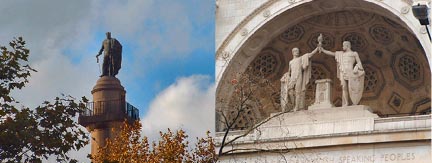
Former Statues of Male Aspiration in London: Duke of Wellington and BCC Building (Photos by Knowledge of London
Event Horizon (GEH) tag on Flickr
Patrick Cates Photos with Long Distance Views
BBC News Story on Event Horizon with Gormley Interview
"Event Horizon" video by Leonardo Tura by music from "Religion" by Phillip Glass.
"Another Place" video by sundaeg1rl with music from 'Hibiscus on the Water' by Peter Ware, played by Yvar Mikshoff.
Antony Gormley made 100 cast-iron sculptures from a mould of himself, then planted them firmly in the shoreline at Crosby Beach, Merseyside, gazing out across the sea. How much you can see depends on whether the tide is in or out.
For many years, I have believed that painters make better architects than sculptors. Painters and architects share a love for the contradiction of the illusion of space and the reality of the object. They succeed with the visual beauty of shaped stuff in a contained volume and with the felt relationships trapped in the volume.
Sculptors like the stuff too much. The architecture of the sculptors tends towards elaborate construction methods to celebrate the stuff. Weight dominates. Space dissipates.
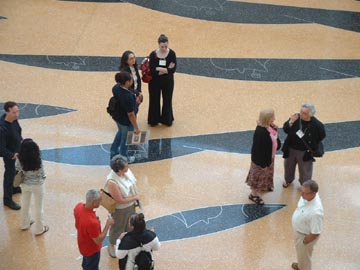
Public Art Administrators in Miami
Break for the facts. On May 9-11, the Miami-Dade Public Art Program hosted the annual conference of Florida Association of Public Art Administrators. The 30 attendees were treated to a private tour of the new $500 million Carnival Center for the Performing Arts. Ivan Rodriquez and Brandi Reddick of the Public Art Program led us to each of the five works with a total art budget of more that $4 million. End of break.
Break for Links to Pictures:
1. General Photos of Carnival Center and Art from Sun-Sentinel
2. Aesthetic Ground Photos from May 10, 2007 Tour
Back to essay.
Architect Cesar Pelli leans toward the sculptor. His first recognized structure - 1975 "Blue Whale" in California - demonstrates his continuing interest in shaped, giant enclosing forms that stand as objects at the scale of the campus, district or city. There is no spatial complexity. You have the building and city next to each other.
The interiors are simple spaces connected by clear passages without much overlap except by volume. By volumetric overlap, I mean you walk under a sculptural shape protruding into another volume. Space is merely the air.
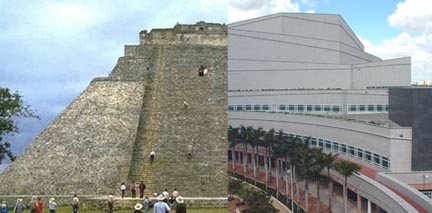
Uxmal and Carnival Center
In Miami, he designed two mountain-like forms in the tradition of Central American pyramids or Buddhist stupas. The non-level topographic breaks are illuminated at night like a "sound and light show" at various pyramids worldwide, but the hipsters of Miami are upset at the building's lack of flash and more importantly lack of architectural praise in the media. Somehow a building like a mountain is considered "conservative". The public acceptability of the architectural innovation has dramatically changed since Gehry's curving metal.
Rodriquez told the Florida Administrators that Pelli wanted to assign the public art to particular locations or boxes. Apparently, Pelli won except for the dynamic floors by Jose Bedia. Pelli prevents the artwork from arbitrary application to the architecture and seeks locations where the artwork can sing freely. In effect he asks the artworks to be simple and contained objects like attributes of his own buildings. The artworks are never interventions into the architecture, but respected creative works within the architecture or urbanscape.
Of the artists, two are subtle decorators, two are powerful painters and one is a performance artist. No sculptors. The decorators - Anna Valentina Murch and Robert Rahway Zakanitch (even decorative names) - blend into the landscape or interior design. Murch's lovely fountain imitates a sandy beach and functions as a picture frame for Diana Balmori's much more aggressive plaza design. Although Murch has completed at least two new similar cascading fountains with sound artist Doug Hollis in California, the delicate sounds are lost to the traffic.
Zakanitch was one of the founders of the 1970s Pattern and Decorative movement in American art - the forgotten partner to Feminist Art. Zakanitch's paintings can be fun with high contrasting simple objects from daily life or decorative traditions like lace. Unlike Murch's frame, Zakanitch curtains are the framed objects - the opera theater curtain and temporary scrim backdrop. Scrim glows radiantly in the intimate blond wood, vulva inspired concert hall. Acoustically, the opera hall may be successful, but all the designers failed in this almost ugly space.
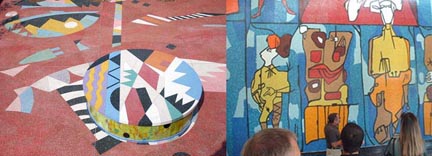
Gary Moore ----- Cundo Bermudez
Two artists - Gary Moore and Cundo Bermundez - selected isolated corners without any requirement for architectural integration. Both artists were free to use the assigned space without control - a benefit of the Pelli system of public art. Moore - a Miami visual artist with performance passions - chose the abandoned backside for a sprawling colorful painting on the plaza. A dance platform or turntable is provided with disco lights under the planters. Bermundez, a 90-year-old Cuban exile, transformed one of his paintings into glass mosaics. More agencies should steal the Honors public art program of King County (Seattle area) to commission large-scale public artworks by local masters that never apply for such things. Thank you King County (4Culture.org) for one of the best ideas in public art administration ever.
Finally to Jose Bedia on the floors of the lobbies of both halls. After a decade of commissioning artists for terrazzo floors around the USA, someone - thank god -hired a painter. Most of these terrazzo floors are by professional public artists that have no substantial reputation for painting. These floors are calm and without any interest to look at more than once. They frequenlty contain small objects that are installed in a random or "follow the path" pattern. Historic and landscape themes dominate. The surrounding architecture has no interaction from the blandness.
Bedia shows what a painter can bring to public art and I say "Bring it on!" The giant elongated hands fill and fight the edges of the space just like a good canvas. The works made me run up the stairs to different balcony levels to see my favorite parts of the work. At the highest level, the powerful graphic anchors the tight narrow lobby. On the ground, Bedia provides images - faces, fish, stars - at the same 6 to 8 foot size of his canvas. At every distance, the eye is filled with a full composition. What more can you ask than to enjoy the art from different locations over and over and over again?
I don't know if Pelli is pleased since the work visually defeats the architecture. But I am pleased with the courage of Miami-Dade to select a mature, aggressive painter with very limited public art experience. I hope this is a new direction in public art - the rebirth of painting for public buildings.
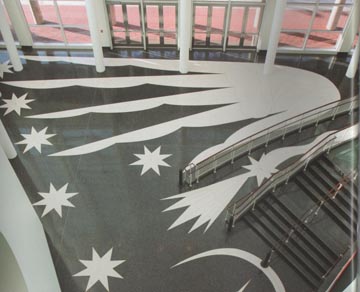
Jose Bedia
So we live in time of virtual motion. After many years of special effects in action adventures shot after Star Wars, we have "direct" experience with fast, twisting motion through space. Billions of humans know things about motion that have never been experienced. Any water cooler conversation can discuss the feeling of a high-speed chase on the ground or through the air.
Video by Rhett Nye
Motion has had a huge influence on architects and many have attempted to capture this spirit since the beginning of the 20th century. Frank Gehry and Zaha Hadid are the best known in the last few years. But unfortunately, we only move slightly faster than a snail through the zippiest of spaces. Architecture is motionless motion.
Public Art has achieved some action through the apparent motion of LED lights or the actual motion of water over surface, lightweight objects pushed by the air or a few motorized elements. But the action is not with the body like the film. Only the amusement park crudely mimics the motion of film.
What about from the other direction? How does the architecture, public space or public art inspire the film or video maker? What kind of works is more conducive to movement of the camera? And therefore the movement of the body? (And are these linked?)
For most films, the specific architecture or art is stylistic or psychological. Terry Gilliam's "Brazil" is one of best uses of architecture and space as another character in the film. Wim Wender's Wings of Desire is one of the finest portrayals of modern space as the angels move through Hans Sharoun's Berlin Library.
For public art, I don't know many. This week at the local movie theater, I watched "The Namesake" in which Diller and Scofidio's Kennedy Airport monitors play a significant role. Very unusual.
To discover how public art might look on film, I searched YOUTUBE and found a selection. Only in a minority of videos do the artworks spark motion in the cameraperson. Most are really just stills shot in video. If a person can walk through the sculpture, the use of motion is more prevalent like Christo's Gates. Cloud Gate in Chicago generated less video fun that I would have guessed. The Tate Modern has sponsored a number of works with video response.
Have a look at the new Aesthetic Grounds YouTube site. Click on the PLAYLISTS to see the Best I could find on particular works.
Tate Modern
Blogroll
AJ Ads
AJ Blogs
AJBlogCentral | rssculture
Terry Teachout on the arts in New York City
Andrew Taylor on the business of arts & culture
rock culture approximately
Laura Collins-Hughes on arts, culture and coverage
Richard Kessler on arts education
Douglas McLennan's blog
Dalouge Smith advocates for the Arts
Art from the American Outback
For immediate release: the arts are marketable
No genre is the new genre
David Jays on theatre and dance
Paul Levy measures the Angles
Judith H. Dobrzynski on Culture
John Rockwell on the arts
Jan Herman - arts, media & culture with 'tude
dance
Apollinaire Scherr talks about dance
Tobi Tobias on dance et al...
jazz
Howard Mandel's freelance Urban Improvisation
Focus on New Orleans. Jazz and Other Sounds
Doug Ramsey on Jazz and other matters...
media
Jeff Weinstein's Cultural Mixology
Martha Bayles on Film...
classical music
Fresh ideas on building arts communities
Greg Sandow performs a book-in-progress
Exploring Orchestras w/ Henry Fogel
Harvey Sachs on music, and various digressions
Bruce Brubaker on all things Piano
Kyle Gann on music after the fact
Greg Sandow on the future of Classical Music
Norman Lebrecht on Shifting Sound Worlds
publishing
Jerome Weeks on Books
Scott McLemee on books, ideas & trash-culture ephemera
theatre
Wendy Rosenfield: covering drama, onstage and off
Chloe Veltman on how culture will save the world
visual
Public Art, Public Space
Regina Hackett takes her Art To Go
John Perreault's art diary
Lee Rosenbaum's Cultural Commentary
Tyler Green's modern & contemporary art blog
